The majority of hearing-impaired individuals exhibit a loss that is predominantly high frequency in nature. In some cases, hearing loss in the higher frequencies (eg, above 1500 Hz) can be quite severe, while hearing thresholds in the lower frequencies (eg, 1000 Hz and below) may remain normal, or near normal. Even though these individuals have normal hearing for a large portion of the speech signal, because of the importance of high-frequency speech cues they can have significant communication problems, especially with understanding speech in the presence of background noise. High frequency hearing loss is progressively becoming a primary motivator for individuals to seek assistance. Until recently, completely effective solutions were not available for most patients.
A fitting solution for these patients has recently been introduced by Siemens Hearing Instruments. ACURIS Life is a hearing instrument endowed with a multitude of features to enhance effectiveness and meet the criteria necessary for open fitting products. These requirements are:
Provide Adequate High-Frequency Amplification
As can be observed in a speech audibility index, such as that of Mueller & Killion1 shown in Figure 1, approximately one-half of critical speech information lies at 2000 Hz and above. The frequency region above 3000 Hz contains one-quarter of the speech information. Notice that for the patient displayed in Figure 1, what is considered a “mild” hearing loss by some, results in a significant loss of audibility for average speech (the blue portion of the speech spectrum is not audible). These patients, therefore, need to be fitted with technology that allows for application of a significant amount of gain for these high frequencies.
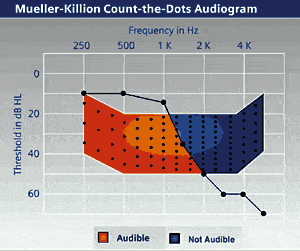
FIGURE 1. The Mueller-Killion Count-the-Dots Audiogram.1 The graph indicates that—for this patient with normal low frequency hearing, sloping to mild-moderate high frequency hearing loss—most of the speech signal is inaudible. The blue shaded area represents inaudible dots. In this case, almost 60% of the speech signal is not heard by the patient.
Of course, providing a large amount of gain in the high frequencies often leads to acoustic feedback. To accomplish high frequency amplification for this type of patient, therefore, it is necessary to utilize a hearing instrument that has many discrete, highly adjustable channels of gain, and a fast-acting feedback reduction system. Acuris Life has 16 channels of gain adjustment, which allow for precise shaping of the response, depending on the audiogram configuration and requirements.
Avoid Amplification Where Hearing is Normal
One of the primary keys to success for fitting individuals with high frequency hearing loss is to be able to provide adequate gain in the high frequencies, yet not provide unnecessary gain where the patient has normal hearing. In some instances, when a precipitous downward sloping loss is present, gain levels must change by 15-20 dB within an octave. The 16 channels of gain adjustment in the new instrument allows the fine-tuning essential to fit any type of audiometric configuration. Also, the channels are overlapping, which allows for a smooth transition when gain changes across frequencies.
Avoid Loudness Discomfort
Individuals with high frequency hearing loss have dynamic ranges that may change significantly in different areas of the frequency range. While the hearing loss may drop by 30-50 dB within an octave, because these losses are nearly always of cochlear origin, the patient’s loudness discomfort level (LDL) changes very little; this requires special processing of the input signal. Speech and environmental sounds, ranging from very soft to loud, need to be carefully repackaged into the patient’s residual dynamic range. In the lower frequencies, the dynamic range may be at or near normal, and small compression ratios are needed. In the higher frequencies, the dynamic range may be only 30 dB, and ratios of 3:1 may be necessary to appropriately repackage the wide range of sounds in the patient’s environment. Moreover, it is important to maximize headroom so that high-level inputs can be placed at a level that falls just below the patient’s LDL. This requires the use of multi-channel AGCo.
To address the variable dynamic range issue, Acuris Life utilizes the 16 independent channels of frequency shaping and AGCi, with adjustable kneepoints and ratios to accommodate a wide variety of hearing losses. This product also provides the option of selecting short or long compression time constants in four programmable regions, so that speech signals can be optimized for both the large and small dynamic range regions.
Another important compression feature is the 16-channel AGCo system. Using this technology, the output for louder sounds is not unnecessarily “capped” in channels where the kneepoint has not been reached, as it would be in a single-channel system. This results in expanded headroom, increasing the utilization of the patient’s residual dynamic range while maintaining the output below the patient’s loudness discomfort.
Avoid Acoustic Feedback
A fitting that leaves the ear canal open allows unwanted low-frequency energy to escape and also eliminates the problem of the occlusion effect (own voice sounding “hollow”). Unfortunately, an open fitting often creates another problem: acoustic feedback. In order for an open fitting to be successful, the hearing instrument needs to utilize effective algorithms for FirstFit™ and feedback management.
An Open algorithm was designed specifically for these fittings to incorporate correction factors for changes in RECD that naturally occur with instruments that have this type of design. This fitting algorithm results in gain and output that couples with the patient’s residual open-ear acoustics to provide not only necessary audibility, but an amplified signal that is rated highly for quality and pleasantness.
Along with this algorithm for FirstFit success, open instruments also must employ an effective feedback cancellation algorithm. The adaptive feedback cancellation system in the new device is designed to solve the problems often encountered with open fittings. A high-speed phase-cancellation system is utilized to address feedback occurrence. This system employs extremely fast adaptation to changes in the feedback path, with maximum energy efficiency (less than 50 uA current consumption). A detector specifically designed for analysis of feedback allows the system to determine the source of feedback (internal or external), and avoids inappropriate cancellation of environmental tonal signals, such as microwave beeps, music, etc. The feedback cancellation design does not require any optimization procedure with the instrument in the ear in order to pre-set any cancellation filter, as some other systems do. The cancellation system is adaptive and does not have any impact on gain or frequency response of the hearing instrument, thereby maintaining sound quality and intelligibility.2
Avoid Occlusion Effect
When we talk, signals of 130 dB SPL or more are developed in the back of the throat. These high-intensity speech signals set the mandible into vibration, which in turn sets the cartilaginous portion of the ear canal into vibration. This creates an air conduction signal with its greatest energy in the low frequencies.
When the ear canal is open, the majority of this increased energy escapes, and we judge our voice as sounding “normal.” If we plug the ear canal with an earmold or a custom hearing instrument, the energy can no longer escape—this results in increased pressure placed on the eardrum, and what we then hear is a more “hollow” sound to our voice. This is called the occlusion effect. It can increase the low-frequency components of speech by 20 dB or more, and most hearing instrument users find it annoying, sometimes to the extent that they will no longer wear their hearing instruments, or will only use one.
It is difficult to eliminate the occlusion effect with simple venting. It is often not possible to make a vent large enough to leak out all the sound, especially for energy at 500 Hz and above. To eliminate the occlusion effect, therefore, it is necessary to use a specially designed earmold. For the effective release of low-frequency sounds, this earmold must be used with the appropriate adaptive feedback control (see discussion in previous section).
Acuris Life is designed without a conventional earhook; instead, there is a small adaptor connected to an extremely thin tube, called LifeTube. The LifeTube is connected to a non-occluding tip to be placed in the ear canal, called LifeTip. These components allow the fitting to remain open and comfortable, and minimize or eliminate the occurrence of the occlusion effect. LifeTubes and LifeTips are available in a variety of sizes and are provided initially to each hearing care professional fitting the product in the Life Fitting Set (composed of a supply of 6 sizes of pre-formed LifeTubes, 2 sizes of LifeTips, and additional tools and accessories for fitting the hearing instrument).
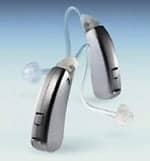
Cosmetically Acceptable
Nearly everyone wearing hearing instruments is concerned with how the instruments affect their appearance. Research has shown that the negative stigma associated with wearing hearing instruments (ie, appearing old or handicapped) is one of the leading reasons that people with hearing loss do not purchase instruments. Individuals with only high frequency hearing loss are even more concerned with the size of the hearing instrument. This is because they view themselves as having a “mild problem” (which is sometimes true) and therefore only need a “mild” (translatable as “small” to them) treatment. The new hearing instrument (Figure 2) is exceptionally small—almost invisible when worn behind the ear—and is available in a variety of colors that are designed to blend with hair or skin color.
Binaural Hearing
As described in the preceding section, several technology features are desired to effectively provide successful hearing instrument fittings for the high frequency loss patient. There is one other area to consider, however—binaural hearing. Approximately 90% of individuals with high frequency hearing loss are candidates for binaural amplification. It is important that these patients are fitted with hearing instruments that offer true binaural processing, and also that the use of the two instruments is as convenient to the patient as possible. Extensive research has shown that binaural hearing has inherent advantages, including improved signal-to-noise ratio, improved localization, loudness summation, expanded residual dynamic range, reduction of head shadow effect, better sound quality, and spatial balance.3
At the core of all Acuris products is e2e wireless synchronization, which allows the benefits of the product’s core technology to be harmonized in two hearing instruments working together as one system. The wireless technology allows communication and synchronization of selected core digital signal processing features in Acuris Life. This is especially important for individuals with high frequency hearing loss, as they often lead active lifestyles and need to minimize the need for making hearing instrument adjustments. Since there are no controls on the new instrument, the wireless function allows the use of an optional ePocket™ remote control, which adds volume control and program selection functionality, when desired. The ePocket is a bi-directional remote control that allows not only user control for volume and memory, but data readout of current volume level, memory setting, and battery status for both instruments simultaneously.
The wireless technology also enables the binaural instruments to function as one comprehensive system by exerting control over Binaural Precision Environmental Classification and Binaural Digital Speech and Noise Management.2,4
Preliminary Research Findings
Clinical studies on the new hearing instrument are ongoing, but some preliminary results are available. To evaluate the effectiveness of the Open algorithm and High Speed Feedback Cancellation system, a randomized blinded study was conducted at University of Oldenburg with 20 subjects (10 experienced and 10 inexperienced hearing instrument users). The subjects compared in several different real-world listening situations the Acuris Life to an alternative open product commonly sold in the US.
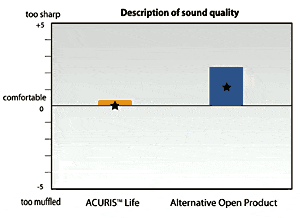
FIGURE 3. Subjects’ sound quality rating after FirstFit using live speech input for Acuris Life and the alternative open product. Subjects were asked to rate the sound quality on a scale ranging from “too muffled” (-5.0) to “comfortable” (0.0) to “too sharp” (+5.0). The range shown is the 25th to 75th quartile. The star within the range represents the group mean.
Figures 3-4 show that patients reported a comfortable, natural sound following FirstFit with the Open algorithm. The majority of these patients also indicated that the new instrument was more comfortable and natural sounding in comparison to the alternative open product. Notice that, in Figure 3, for the new device, the 25th-75th quartiles are tightly clustered around the mean rating, which is close to the desired “comfortable” descriptor. For the alternative open product, there is a wider range of responses, with the mean response skewed toward the “too sharp” continuum.
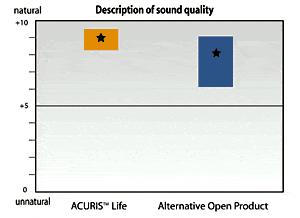
FIGURE 4. Results when subjects were asked to give ratings for the description of sound quality after FirstFit with live speech input for Acuris Life and the alternative open product. Subjects could select ratings from “unnatural” to “natural” on an 11-point scale from 0-10. The range shown is the 25th to 75th quartile. The star within the range represents the group mean. For Acuris Life, the mean was 9.0; for the alternative open product the mean was 8.2.
Similarly, in Figure 4, the 25th-75th quartiles for the new product are tightly clustered around the mean rating (approximately 9.0), while the responses for the alternative open product exhibit a wider range of responses, with the mean response at approximately 8.2.
The High Speed Feedback Cancellation system was evaluated after First Fit during the same study. Initially, subjects were asked to judge the presence of feedback in the laboratory, after the fitting of the instruments. As shown in Figure 5, patients fitted with the new system did not experience feedback (mean rating of almost 10.0). The alternative open product exhibited feedback in a significant number of cases, with a range of responses and a mean response of approximately 8.0.
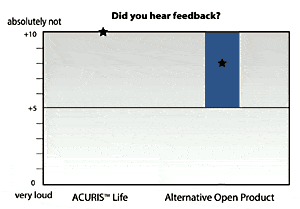
FIGURE 5. Subjects rated the occurrence of feedback after FirstFit on a scale indicating whether feedback was “very loud” (0.0) to “absolutely not” (10.0, no feedback). The range shown is the 25th to 75th quartile. The star within the graph represents the group mean. For Acuris Life, the ratings were the same for the 25th to 75th quartile with a mean of 10.0. For the alternative open product, the mean was 8.0.
Finally, in a field trial, the subjects were asked to rate the occurrence of feedback in everyday listening situations. As shown in Figure 6, subjects wearing the new open-ear system rarely or never experienced feedback in these situations, with the 25th-75th quartiles tightly clustered between 9.8 and 10.0. For the alternative open product, the range of responses was wider and the mean response was approximately 8.2.
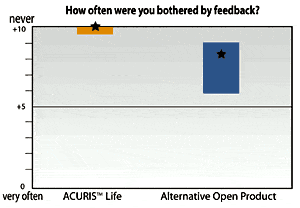
FIGURE 6. Subjects were asked to rate feedback occurrence in everyday life, following FirstFit for Acuris Life and the alternative open product. The rating scale ranged from “very often” (0.0) to “never” (10.0). The range shown is the 25th to 75th quartile. The star within the range represents the group mean. For Acuris Life, the mean was 10.0; for the alternative open product the mean was 8.3.
Summary
Acuris Life with e2e wireless is designed for patients with binaural high frequency hearing loss or those with monaural loss who wish to have a discreet, immediate, open-fitting solution with high-level core signal processing. The device is the first to combine the digital technology necessary for open fittings with the advantages of wireless communication. Through the effective use of digital signal processing, noise reduction, and fast-acting adaptive feedback reduction, it is now possible to appropriately fit millions of people who could not be effectively fitted before.
| This article was submitted to HR by Pamela Burton, MA, director of product management, and Thomas A. Powers, PhD, chief research officer at Siemens Hearing Instruments, Piscataway, NJ. Correspondence can be addressed to HR or Thomas Powers, Siemens Hearing Instruments, 10 Constitution Ave, Piscataway, NJ 08854; email: [email protected]. |
References
1. Mueller H, Killion M. An easy method for calculating the articulation index. The Hearing Journal. 1990;43(9):14-17.
2. Powers T, Burton P. Wireless technology synchronizes DSP and user controls for true binaural amplification. The Hearing Journal. 2005a;58(1):25–34.
3. Mueller HG, Hall JW. Audiologists’ Desk Reference. Volume II. San Diego: Singular Publishing Group, Inc; 1998.
4. Powers T, Burton P. Wireless binaural synchronization in hearing aids: questions and answers. The Hearing Review. 2005b;12(1): 28–30;89.




